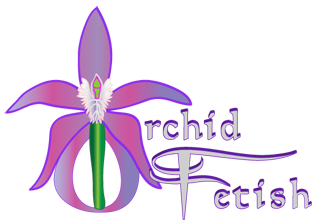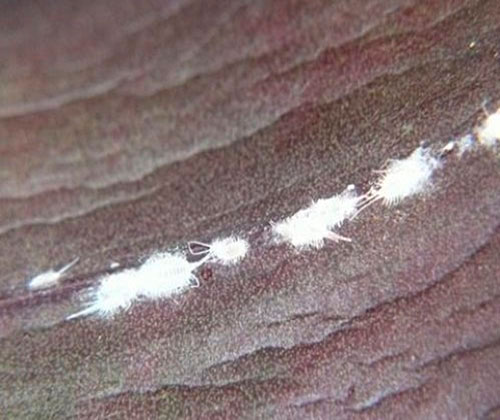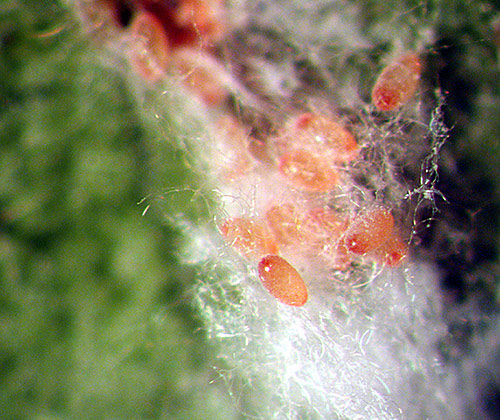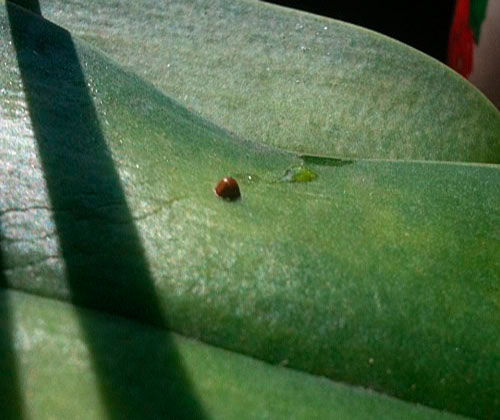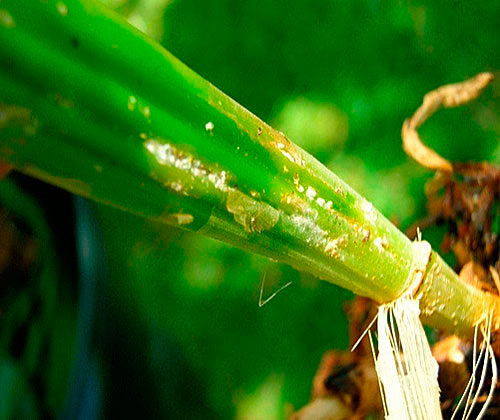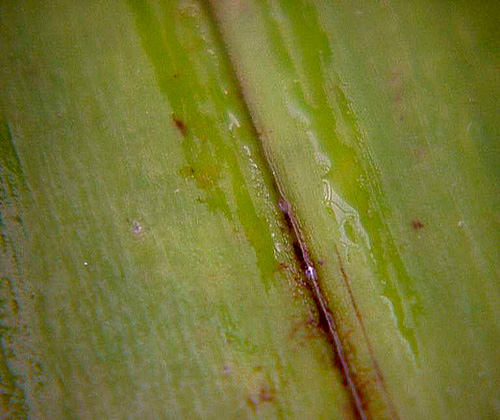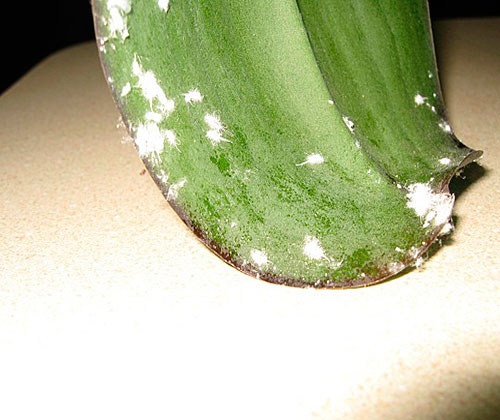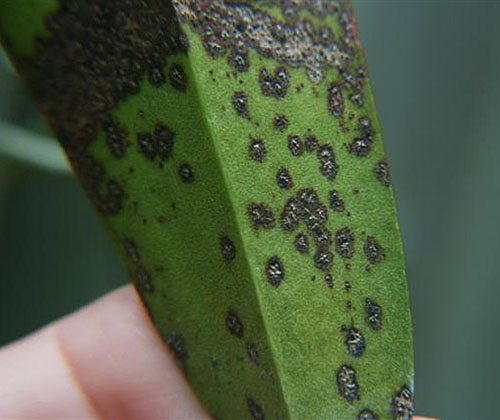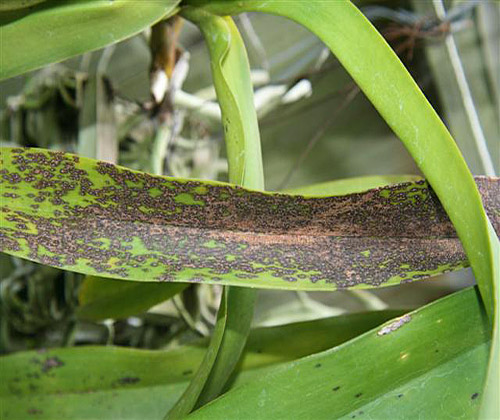Orchid Disease, Disorders & Pests
Orchid Disease
There are many types of orchid disease issues which include fungi, molds, viruses, and weeds that can attack orchids, as well as environmental damage such as sunburn, leaf dieback, drought, or cold withering. The most common orchid pests are scale, mealy bugs, thrips, and mites, especially if you’re growing orchids as houseplants. You can treat small pest problems on some orchids by dabbing the pests with a cotton swab that’s been dipped in rubbing alcohol, mixed with dishwashing liquid ( preferably plant-based or Dawn). For larger infestations, you can wash the plants with water or use a horticultural oil or soap spray that’s safe for use on orchids. Hydrogen Peroxide baths are also quite successfule for many disease issues. You may need to repeat this process to get the pests in check. If the pests still won’t go away, you can search for a stronger insecticide that’s safe to use, though you should always start with the least toxic products first. Remember to check your orchids often for pests so that you can take action before small problems from become bigger ones.
Overwatering or Underwatering
Underwatering tends to result in plants losing leaves; most orchids won't wilt when dry. Pseudobulbs will shrivel, though. New growths may fail to expand properly and have accordion-like creases, either lengthwise or perpendicular to the leaf's central crease. Or the plant may simply be weak and fail to bloom. Overwatering produces similar symptoms to underwatering: it causes the potting mix to break down, smothering the roots, or may simply cause the roots to rot. In either case, the plant can't get enough water anymore! If a plant has underwatering symptoms but you're not sure whether you're overwatering or underwatering, inspect the root system to find out if it's rotten; try to lift the plant out of the pot with its potting mix to look at the roots. (Clear plastic pots make monitoring root health easier, so I like to use them.) If the root system is in bad shape, repot the orchid, removing all the old, dead roots. If it has few roots left, you may want to raise the humidity to help it recover.
Orchid Weeds
If another plant is competing with your orchids, such as ferns, Oxalis, or anything else, it's a weed. It might be a nice plant, but it's not in the right place, so either move it to another pot or kill it viciously. You might have to repot the orchid to get rid of it. It's best to do this before the weed goes to seed, or the problem can multiply through an entire orchid collection.
Orchid Viruses
There are several kinds of viruses that can affect orchids. These typically appear as stripes or streaks on leaves and/or flowers, usually of dead, brown tissue. Orchid viruses are incurable; either discard the plant or isolate it from the rest of your collection. Different viruses affect different types of orchids, and each has its own characteristic pattern of dead tissue. But identifying the virus is irrelevant since they are all incurable. To avoid spreading orchid viruses, sterilize any cutting tools you use on your orchids in between plants. You can do this with bleach, blowtorches, or in the oven. You can also use disposable razor blades that you throw away after each plant. This should be done any time you trim orchids, such as when removing old roots in repotting, or when dividing orchids.
Bacterial Infections and Fungal Infections
There are many possible bacterial and fungal infections of orchids. These are most common in plants that are being overwatered (e.g., root rot) or whose foliage is often wet. Automatic misting systems can cause the latter problem, as can letting water settle into the crown of a plant (to which Phalaenopsis are especially vulnerable, since the configuration of the leaves prevents the water from draining away).
Phyllosticta Capitalensis Symptoms:
This fungus causes leaf spots on all major hosts are in the orchid family, and belong to genera such as Brassolaeliocattleya, Cattleya, Cymbidium, Dendrobium, Epidendrum, Laelia, Laeliocattleya, Odontoglossum. Oncidium, Phalaenopsis, and Vanda.
Phyllosticta capitalensis has also been reported on Guzmania and Nidularium of the bromeliad family in Florida. In Hawaii, this fungus is common on many cultivars of dendrobium.
On dendrobium, young leaf spots are typically yellow or black, circular, and small. These spots remain unchanged for many months . However, the fungal growth within the leaf tissue eventually increases and tan to brown rots develop. Within the next week or two, the entire leaf is killed and the characteristic, black web-like pattern formed by this fungus on diseased leaves is observable. When the flowers are harvested or drop from age, a black rot rapidly covers the flowers in 1 or 2 days.
To help avoid all the various kinds of rot, it is best to avoid overwatering, and to water plants early in the day as they will tend to dry more quickly when there is still plenty of light and temperatures are warmer. Also make sure there's plenty of air circulation, such as by positioning fans near your orchids.
For leaf rot, cut off the infected part of the leaf. Crown rot also requires cutting off the infected tissue, though you'll feel really bad about it since that's the plant's growth tip! For root rot, repot the plant, taking care to trim off all dead and dying roots. Though orchids don't like being pruned, pruning orchids to remove diseased tissue can save a plant's life.
Sometimes fungal diseases will affect orchid flowers, producing various types of brown spotting. Remove affected flowers and hopefully it won't spread to the rest. Also be sure to discard the flower stem promptly when the plant goes out of bloom.
You can also use a bactericide or fungicide such as Phyton 27 to help control most of these infections. Follow the manufacturer's instructions.
Sunburn
If leaves are exposed to enough sunlight that they overheat, those parts of the leaf will die, leaving brown or black splotches. This damage is generally irreversible; the best thing to do is reduce the lighting. Plants can also adapt to higher lighting over time; sunburn is most common when a plant has just been taken outside for the summer and is getting too much sunlight!
Cold Damage
If you've been growing orchids outdoors, you might occasionally see cold damage from unusually cold weather or as winter approaches. It's best to check the weather forecast and bring plants inside before this happens. Should a freeze affect your orchids despite your best efforts, many of your orchids will survive if you're lucky. There might be some damaged leaves, though; affected parts of the leaves tend to collapse and become thin, as frost crystals have punctured the cell walls. Generally, there's nothing to be done in response to this damage, though you should remove any large portions of dead tissue.
Fertilizer Burn
If the tips of the leaves turn brown, this may be due to too much fertilizer, or to fertilizer salts having built up in the orchid's potting mix. In the latter case, simply repot and make sure to flush the plant with water regularly to prevent salt buildup in the future. Of course, if you're overfertilizing use less fertilizer! The general rule for orchids is to fertilize "weakly, weekly".
Orchid Pests
There are a wide variety of possible orchid pests. I can only describe some of the more common ones here, but feel free to ask questions or talk about your own pest battles below! Orchid weeds are pests of a different enough category that they have their own page. If you keep your plants outdoors, they have a much greater chance of being exposed to pests than if you keep them indoors. So if you live in a temperate climate, inspect your plants thoroughly when you bring them indoors for the winter! It's also a good idea to check new plants for pests before adding them to your collection. Serious orchidists might want to have a separate quarantine area for new plants, and keep them there for a month or two to monitor for pests, diseases, and weeds. These are some of the more common types of orchid pests:
Snails and Slugs
If you start noticing holes eaten into your plants' leaves, these are likely culprits. Their slime trails may also give them away. They tend to come out at night, so it might be advisable to do midnight raids with a flashlight and squish any of the evil critters you find! There are also pellets that you can spread around your orchid collection that will attract them and poison them. Caterpillars and grasshoppers can cause similar damage, but I've never had trouble with them indoors.
Scale insects
These bugs have tiny larvae that crawl around your plant. Then, as adults, they latch onto the plant somewhere (usually in an out-of-the way place,) start sucking its juices, and hide under a waxy covering that looks a lot like a lizard's scale (hence the name.) Though many pesticides will work against these, most don't work very well because the scales protect them so well. There are insecticidal soaps that will stick to them and are effective. The best approach I've found is to rub them off with a cotton swab dipped in a mix of dish liquid (prefer Dawn) and alcohol, then spray a conventional insecticide on the plant.
Aphids
These bugs crawl around a plant, sucking its sap, and often exude a sticky secretion. They are particularly fond of flower stems. They're pretty easy to defeat. Most pesticides will work, and I've had good luck with a spray bottle containing diluted isopropyl alcohol. Something as simple as washing them off with a hose can work too.
Mealybugs
These are sap-sucking insects that like to hide in hard-to-reach places on the plant. Treat them much like scale insects. Mealybugs are sucking insectsthat attack any part of the plant but tend to stay tucked away at the junction of leaf and stem. Severe infestations cause chloroticareas to appear on the leaves, which may darken, causing the leaf to yellow and drop prematurely. Treatment: If there are only a fewmealybugs, use a Q tip dipped in isopropylalcohol or toothbrush dipped in a pesticide like Malathion, Orthene or Safer Soap (used per label instructions) to physically removethe mealybugs. For more severeinfestations, apply the pesticide and repeatthe application 2 weeks later. Be sure to spray all plant surfaces, particularly the undersides of leaves and leaf axils. Prevention: Remove old leaf and flower sheaths to eliminate hiding places and allow easy inspection. Check new plants carefully before adding to the growing area.
